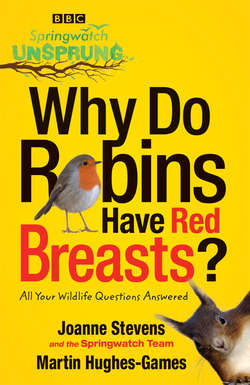Читать книгу Springwatch Unsprung: Why Do Robins Have Red Breasts? - Jo Stevens - Страница 25
Confusing Courtship
ОглавлениеThe males and females of some birds, such as robins, look identical. So how does a male robin know he is chatting up a female robin, and not another fella? And why do they both have red breasts? Sue
Many birds are sexually dimorphic – that is, the male and female look very different. Usually, the males are the more colourful, showy sex and females tend to be more drab. Perhaps the most extreme example of this is the peacock, with its magnificent blue-green tail that creates a dazzling fan. However, familiar British birds such as grouse, blackbirds and many species of duck, such as mallards, also have males that are more eye-catching than the females. Other birds have more subtle cues, such as the yellower chests of male blue tits that are particularly apparent when viewed in ultraviolet light, which birds, unlike humans, can detect.
In 1859 Charles Darwin first proposed that male birds used elaborate plumage to impress females in his book On the Origin of Species. He argued that the males evolved ornaments such as beautiful feathers, or beguiling courtship rituals like the complex dances performed by birds of paradise, to woo the females, which then choose their partners according to their fitness. At the time, Darwin’s entire theory of evolution was controversial and met with much consternation, but the concept of female choice was especially scandalous at a time when women had little control over their lives in a patriarchal Victorian society.
Anyway, back to robins! Robins are unusual because both males and females hold territories throughout the year and defend them vigorously. Their red chest feathers act as a warning to other robins rather than an attraction to potential mates. The male and female both have bright orange/red breasts that stand out amid the gloom of dusk and dawn when they are often active. They use their beautiful song and brilliant red chests to see off any intruders. A robin will find a high perch, fluff out the feathers to show as much red as possible then sing out its melodious war song. If the vivid red chest is their war paint, then their song is their battle cry.
Most of the time, the opponent submits and a fight is avoided. If not, the owner will attack, and may even peck the other bird to death. Up to 10 per cent of robins might die in this way. Robins are so feisty that any object of a similar colour may be attacked, like the apocryphal red rag to a bull. We’ve had reports of assaults on orange lawnmowers, red socks and even someone gardening in a red jumper.
From late December onwards, the robin’s thoughts turn to romance, but courtship can be confusing when both sexes look almost the same. The male may be a little brighter and slightly larger than the female but even robins may have difficulty telling the sexes apart. They have to take into account how a robin acts rather than rely on how it looks. During the breeding season, females approach their chosen male’s territory with care. Sometimes, the male mistakes his lover for a fighter and initially responds aggressively, singing at the ‘intruder’. She patiently listens and doesn’t sing back – instead she follows him around. After a few hours, her patience pays off and he finally accepts her. They set up home together and both fiercely defend their patch. Robins may look cute and appealing but they are gutsy little warriors.
